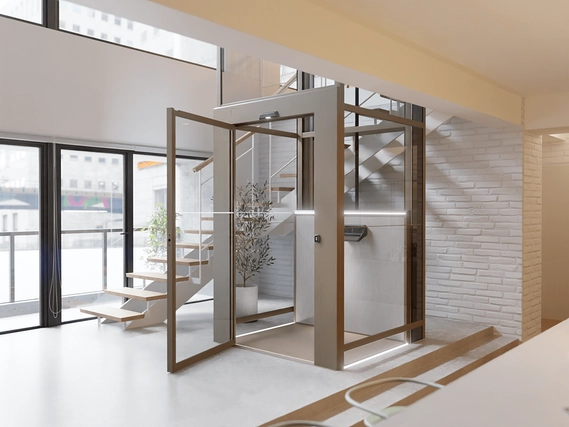If you’re in the planning phase of installing a lift in your home or commercial building, one of the most critical factors to consider is space. Knowing how much room you’ll need ensures a smooth installation process and that your lift functions efficiently while meeting the needs of everyone who will use it. Below, we’ll guide you through the essential questions to ask and the space requirements for different types of lifts.
Key Questions to Ask When Planning a Lift Installation
- How many people will use the lift? Do you need a lift for just a couple of people, or will it need to accommodate more?
- Do you need the lift to fit a wheelchair? If the lift will be used by someone in a wheelchair, you’ll need additional space to ensure comfort and easy access.
- Will someone assist the person in the wheelchair? If so, the lift will need to be large enough to fit both the wheelchair and the assistant, which requires more room than a standard lift.
Answering these questions will help you determine the right size and type of lift for your needs.
Standard Lift Sizes
Lift sizes vary depending on how many people need to use it and whether it will need to accommodate a wheelchair. Here’s a breakdown of typical sizes:
- 2 People Lift
- Standard Cabin Size: 800 mm wide by 1,000 mm deep (minimum)
- This is one of the most common lift sizes for homes with limited space and is ideal for just one or two people.
- 1 Wheelchair + 1 Person
- Standard Wheelchair Cabin Size: 1,100 mm wide by 1,400 mm deep
- For wheelchair users, this is the minimum space requirement to ensure the wheelchair fits comfortably with room for a second person. This will fit 90% of the wheelchair sizes.
- Compact Wheelchair Cabin Size: 1000x 1300 mm (WxD), this size will fit up to 80% of the standard wheelchair sizes
- 1 Wheelchair + 1 Assistant
- Standard Cabin Size: 1,200 mm wide by 1,400 mm deep or more
- If someone needs assistance in the lift, you’ll need a little extra room to accommodate both the wheelchair and the assistant.
These dimensions help provide a sense of the space needed for your lift’s cabin. However, it’s essential to remember that the lift’s shaft – the vertical space where the lift operates – will require more room than just the cabin.
Space Needed for the Shaft and Pit
Shaft Dimensions
The shaft (also called a hoistway) is the enclosed space where the lift travels between floors. The shaft must be slightly larger than the cabin itself. For example:
- For a cabin that is 800 mm wide by 1,000 mm deep, the shaft will need to be at least 1,200 mm wide by 1,300 mm deep.
- For a larger lift with a cabin size of 1,100 mm by 1,400 mm (for a wheelchair and another person), the shaft might need to be around 1,500 mm wide by 1,800 mm deep.
Headroom Requirements
The headroom is the vertical distance from the floor of the top level to the ceiling where the lift will be installed. Most home lifts will need about 2,400 mm to 2,600 mm of headroom, but this can vary depending on the type of lift and any machinery requirements.
Pit Requirements
The pit is the small space below the lowest floor where part of the lift’s mechanism is housed. The pit allows the lift to be flush with the floor when it’s at the lowest level, making it easy to enter and exit.
For most residential lifts, the pit will need to be at least 100 mm to 300 mm deep. Commercial lifts, which may carry heavier loads, will likely require a deeper pit – sometimes up to 600 mm.
If you’re renovating an existing building, creating a pit may involve some excavation, so it’s crucial to plan for this.
Understanding the Space Required
Now that you know about cabin size, shaft dimensions, headroom, and pit requirements, here are some example space requirements:
- For a lift for 2 people (800 mm by 1,000 mm cabin): You’ll need a shaft that’s at least 1,200 mm by 1,300 mm, with headroom of around 2,400 mm.
- For a wheelchair lift (1,100 mm by 1,400 mm cabin): The shaft will need to be at least 1,500 mm by 1,800 mm, with a similar headroom requirement of around 2,400 mm to 2,600 mm.
- For a larger lift with wheelchair and assistant (1,200 mm by 1,400 mm cabin): You might need a shaft that’s at least 1,600 mm wide and 1,900 mm deep.
Conclusion: Plan Ahead for a Successful Lift Installation
Before purchasing a lift, it’s important to assess the space you have available. By considering the number of people, whether it needs to fit a wheelchair, and reviewing standard cabin and shaft dimensions, you’ll have a clearer picture of what’s required.
If you’re unsure about the space you need or how to measure it accurately, Lift Experts can help. We specialise in helping homeowners and businesses find the perfect lift solutions, and we can guide you through every step of the planning and installation process. Reach out to us today for a consultation!

